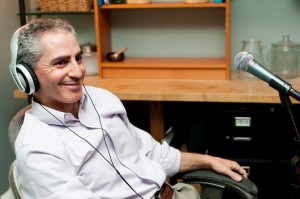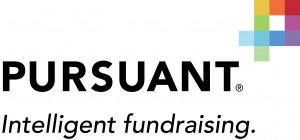Big Nonprofit Ideas for the Other 95%
I love our sponsor!
Do you want to find more prospects & raise more money? Pursuant is a full-service fundraising agency, leveraging data & technology.
Get Nonprofit Radio insider alerts!
Listen Live or Archive:
- On Fridays at 1pm Eastern: Talking Alternative Radio and tune in
- Listen to the July 15, 2016 archived podcast
My Guest:
Marcy Heim: Bring Joy To Your Donors
 Marcy Heim has over 30 years thinking about and perfecting major donor relationships. She’s the Artful Asker and we examine the intersection between fundraising and professional coaching. (Originally broadcast on March 13, 2015.).
Marcy Heim has over 30 years thinking about and perfecting major donor relationships. She’s the Artful Asker and we examine the intersection between fundraising and professional coaching. (Originally broadcast on March 13, 2015.).
Top Trends. Sound Advice. Lively Conversation.
You’re on the air and on target as I delve into the big issues facing your nonprofit—and your career.
If you have big dreams but an average budget, tune in to Tony Martignetti Nonprofit Radio.
I interview the best in the business on every topic from board relations, fundraising, social media and compliance, to technology, accounting, volunteer management, finance, marketing and beyond. Always with you in mind.
Get Nonprofit Radio insider alerts!
Sponsored by:
View Full Transcript
Processed on: 2018-11-11T23:30:19.287Z
S3 bucket containing transcription results: transcript.results
Link to bucket: s3.console.aws.amazon.com/s3/buckets/transcript.results
Path to JSON: 2016…07…298_tony_martignetti_nonprofit_radio_20160715.mp3.350674206.json
Path to text: transcripts/2016/07/298_tony_martignetti_nonprofit_radio_20160715.txt
Duitz hello and welcome to tony martignetti non-profit radio big non-profit ideas for the other ninety five percent. I’m your aptly named host. Oh, i’m glad you’re with me. I’d be hit with hemochromatosis if you hit me with the irony that you missed today’s show bring joy to your donors marcie, i’m has over thirty years thinking about and perfecting major donor relationships. Marci is the artful askar, and we examine the intersection between fund-raising and professional coaching. This was originally broadcast on march thirteenth, twenty fifteen on tony’s take two thank you. We’re sponsored by pursuing full service fund-raising data driven and technology enabled, you’ll raise more money pursuing dot com here is marcy heim and bringing joy to your donors. I’m very pleased to welcome marcie hime to the show. She’s, a life and development coach, author and speaker with over twenty years of frontline major gift fund-raising experience, she’s won awards for her speaking and training, and she hosts marcie’s major gift success club. She promotes both positive mindset and best practice fund-raising she’s at marcy, i’m dot com and on twitter she’s at marcy hime. Marcy, welcome to the show. Thank you, tony. Delighted to be here, i’m glad you are pleased to have you my voice just broke. Look, please, like i’m a fourteen year old again. It happens once in a while. I love going back to fourteen that well, with my voice, nothing else that i was an awkward fourteen year old. Ah that’s, right? I’m an awkward fifty three year old. I’ve never never fit in. Um, let’s say you you work in fund-raising and professional coaching, so we wantto we want to look at the intersection. What? What’s it, that intersection where those two circles overlap? Well, i think tony, it it leads back to my experience when you talk about more than twenty years that’s not really unique there, folks out there that have twenty years of fund-raising experience what’s unique about my experience is that i spent those twenty three years at the same institution. So i had the opportunity to be the first person in a position and grow a program over those twenty three years and spend more than two decades with these same donors, watching them grow and change and increase their giving and change their giving and go from from annual fund to major gift. To to life legacy planning. So it was just a really unique experience to sit back and say, ok, what makes me successful? I had a tremendous run, uh, with the university of wisconsin foundation and had the privilege and opportunity to raise millions of dollars. And as i look back, i realize it’s not just the methods i use, but it’s a mind set that i brought to the business that’s, the mindset that i brought to my work. So i focused my coaching and consulting on a twofold process. One is not just what is the donor thinking? We talk about that? No, no, no, no, no. I’m saying, what are you thinking what’s going on in your head? What do you asking yourself? And that just is important and i think more, tony, then how do we write a good letter? And how what? How many visits should we make in a month and some of those kind of best practices? And how is this mindset that we bring? And i’m glad we have a full hour to talk about it going to bring joy to our donors. What’s the connection? Sure. Excellent question already, it’s only. My second one already has blown. Now. The rest are all going to be lackluster questions. But all right, we have the pinnacle. Now. We’re trailing off already bad questions to come hyre tony that’s, something that really touched my heart because when you’re with somebody was not authentic, you feel it right away when you’re with somebody who’s saying, okay, man, if i asked this question or talk to them about their passions or get into their head about, maybe i’ll get the money, and i’m not saying where scheming is that. But when you think about some of the words we use, right, well, whether you’re a suspect, because i’m not sure if you have enough money or interest yet to be a prospect hyre how does that really make somebody feel? So this whole idea of what goes on in our heads, the words we use, earl nightingale said in a program called the strangest secret in nineteen fifty seven, which was, by the way, the first vulcan recording to sell a million copies, he said, our success is determined by what we think we become, what we think about so when we are thinking sincerely in authentically about how can we provide an opportunity for this person sitting across from us two and back in a cause that gives them excitement and joy? It totally shift the relationship building experience, and it gives that donor a completely different outcome not on ly the direct impact they’re giving has but this sense of joy. You know that when you actually write a check to tony charity charity tony, it releases and yeah, it’s ah, writes that you’re the pleasure writes, the pleasure centers in the brain are activated when you do a charitable act. Yeah, i have ah, i do a keynote called, show your love and raise more money. And i in there i make the point that i want us to avoid the construction metaphors, like building relationships and starting a foundation. Ah, foundation, you know, a foundation for the relationship, and i also avoid as much as i can, sometimes i lapse into it, but and prospekt, you know, i like potential donor. I suspect i i’ve gotten away from that that that i’m pretty good about not using, but occasionally lapse in tow prospect instead of potential donor or, you know, it’s sort of thes air and the construction metaphors, they’re dehumanizing terms they are yeah, i love that. Yes, they’re dehumanizing terms, you know, and just even some of the things in all of my years, i’ve never hit anyone up for money. You know, i’ve never hit anybody. And things like let’s get into their packets? No, they’re loaded. And even some of the things that are maybe more subtle that they’ve so benefitted from organization they should give, they oughta give they always. And who are we to tell somebody else what they should or ought to do with their dollars with their money? So your concern is that the way we think about it, potential donors and donors and the way we talk about them, hopefully behind the scenes in our office, in our conferences, um, is going to transcend those situations and and into our relationships with the people that were were dehumanizing. You bet on let’s get real let’s. Get real direct about it. You just said, well, how we talk about them behind their, you know, basically behind their back. Yeah. Yeah, well, it well, yeah. That’s, that’s the nature of our business. I’m getting a real echo in my head. But i would stake my team that i would never want to talk about a donor behind their back differently than i would talk to them. Yeah, well, that’s a that’s, a that’s. A policy to for written written notes. And you? Know, preserving, preserving things in our cr m you should never write something that you wouldn’t want the person to treat. Yeah. Okay. Um, and i have that really happened to me once. Tony, i had a a woman that was working on a very major investment with the university. And and we had a brand new students on board of the foundation that helped with little mailings. And these kinds of things in her gift have qualified her to be part of one of our honorary organization. So there was a certificate, and i know that you’re not wild about all these things in nor nor am i. But this is kind of what we did. And there’s a certificate that got mailed out. Well, this new students not knowing any better, took her entire record and stuck that was attached to the certificate simply to give her the proper mailing address. Well, she kept the whole thing in the inn with a certificate, mailed it to the donor. Oh, my god. I know well, and how i found out was i got this phone call and this and this girl said to me hi, marcy, you know, i got and i went hello, let’s call er, gladys, i said him oh, gladys, how are you today? And she said, fine and i said, did you get your you know, your certificate? And she said, yes, i did it’s lovely, but i also got another sheet of paper with it, and i said, what was that, gladys? And she said, well, it says, matt with gladys, talk to her about tony, can you imagine? Yeah, oh, my god, you’re yeah, i mean, i almost died back there on the spot gotomeeting her contact, yes, it’s a good thing that wasn’t gladys, gladys kravitz from bewitched should be like, i never remember gladys kravitz, you good thing that wasn’t wait to take a break for a moment or two, everybody else stay with us more on morsi, more with morsi hime bring joy to your donors. You’re tuned to non-profit radio tony martignetti also hosts a podcast for the chronicle of philanthropy fund-raising fundamentals is a quick ten minute burst of fund-raising insights published once a month. Tony’s guests are expert in crowdfunding, mobile giving event fund-raising direct mail and donor cultivation. Really, all the fund-raising issues that make you wonder, am i doing this right? Is there a better way there is? Find the fund-raising fundamentals archive it. Tony martignetti dot com that’s marketmesuite n e t t i remember there’s, a g before the end, thousands of listeners have subscribed on itunes. You can also learn maura, the chronicle website, philanthropy dot com fund-raising fundamentals, the better way. Welcome back to big non-profit ideas for the other ninety five percent. Marcie. I’m you’re still there right now. Here you come back, okay? We have better connection this time. Thank you very much. Um, so what we think is what we become. Can you say a little more about that? We become what we think about so it’s not something. You know, tony, i think people roll their eyes a little bit and say, yeah, yeah, yeah, but but truly, what do we plant in our heads? And we planned in our heads the words that we use, the things that we watch the shows, we watch, the conversations we have, the people we surround ourselves with, and we’re influenced by what people say to us were influenced by our own history by what we were brought up with. You know, for example, if i said to you, tony finished these sentences, money doesn’t grow on trees, blank, rick. Very filthy rich is what most people that’s gross. I didn’t think of that well, i did now, but no very kayman things that those are things that are in our in our heads and some of our feelings about money, some of our some of the things that we have been exposed too far, and i’m not saying our parents weren’t wonderful people or that they did something wrong or right, i’m just saying we’ve got these thoughts, we’ve got these things in our heads, and we need to deal with them, especially when it comes to raising dollars, especially when it comes to the kind of self talk we give ourselves. How many times do we ask ourselves questions? Like, why am i so bad at this? Or why can’t i get how to do this thing on the computer? Or, you know why those air all the negative? Those are all negative questions. Why am i so crummy at this? Why am i so? But why don’t i have more money? Why don’t i have a bigger house? Why don’t i have a nicer car? I mean that that’s all negative self talk, right? And and it’s a lot of times it’s in the form of a question and there’s some wonderful new research that’s happening here at the university, wisconsin and other places that talks about our minds. Tony being kind of like one great big google, you know, when we ask ourself one of those questions like, why am i always late? Our mind will quickly say up you’re late here and you’re late here in your late here, and it’ll google all of those times and throw it right to us. Well, that’s because yeah, but that’s because that’s, the way you frame the question there’s ah there’s, somebody is interesting. Ah, this i don’t know. I don’t know if this person listens to this show regularly, but she he or she tweets very actively on twitter he or she is at the-whiny-donor andi and we have some back and forth because sometimes the person will post things they’re whining about and then i don’t necessarily agree are as bad as you, she thinks, but you know, you’re making me think of the-whiny-donor so that person is always looking for oh, and i should give a little explosion they there there? Ah, twitter profile. Says that there on i think they’re onto boards and at least one of those is a development committee board position but could be both but you know, they’re they’re in fund-raising on on a volunteer level and that’s, why and there’s other at the-whiny-donor and you’re making me think of that person because they’re always there always looking for things to whine about. It’s it’s, how we frame the question that google is goingto answer right? Our google mind is goingto answer based on how how we weren’t it, okay, exactly, and i think that that’s something we need to consciously manage. So in my more major gift workshops and in a lot of my teaching and in a lot of my consultancy, i work with kind of the coaching for the mindset as well as are we using best press practice method? So let me give you a couple of examples about way to reframe these and, you know, i’m sure tony, you’ve heard of affirmations where you make this statement, as if it’s already happened. The problem with that is a lot of times we don’t buy the statement our own hat is saying, like like, the easiest way to think about it is is i don’t, but i would like to weigh one hundred and thirty eight pounds, right? So i stand in front of the mirror and i say i weigh one hundred and thirty eight pounds. Well, i looked back at that. I don’t know, you don’t yeah, right. So part of what the power of asking these questions is, is it becomes something where what we’re really doing is empowering our wonderful mind to pull a pull forward those times when we’ve been successful, to pull and to build on those. So for example, why am i always late becomes, why am i such a non time kind of gal? And i have times that come to mind when when that happens, why? Why does my work take me away from my family boy and development? I hear i’m working all the time. I don’t have enough time for my family. Why am i in this business is so hard. Well, why do i do such a great job of prioritizing what’s? Most important in my work and life, marcie, how, before we start to make these mindset changes, how did we just become aware and conscious of what we’re doing, you know, it’s it’s so ubiquitous, where i mentioned conferences and and the office meetings, you know, these things, they’re reinforced the mindset that you’re trying to move us away from is so reinforced. How can we raise our own consciousness? That’s a really good question, another one. I got two in two in twenty minutes, sometimes people will say, you know, i’m not sure i talk to myself. I talk to myself what i want if i talk to myself, you are talking to yourself, um, there’s some statistic out there, and i’m sorry, tony, i can’t quota, but that we we give ourselves, like sixty thousand messages a day or something like that or we hear him. But it’s, some astronomical number and i think you have to step back and try to be more present. Try to be more aware how does what you’re hearing impact, how you’re feeling and the reason that’s important is what we hear, how we feel impacts what action we take. How does what feel impact what action we take, right? Okay. So so you say you here, boy. It’s really hard to get those first appointment that’s just really hard to do, you know it. And then we say, yeah, you know, and people don’t really want to hear from us there asked, you know, they ask about money all the time, and you’re just another one of those pesky phone calls. Well, that how is that going to empower you and put you in the right frame of mind to make phone calls to set up appointments with your donors? You know, again it’s that negative it’s the it’s, the negative perspective versus the, you know, sort of. Why am i how come i do so well? What is it that makes me do so well at getting the calls, getting the meetings that i do get? Marcie, let me just give me a moment because i have to shout out someone on twitter. Margo o’malley, she’s she’s, new to non-profit radio just discovered her recently and she’s live tweeting the show she’s using the hashtag non-profit radio and on twitter she is at margo underscore om and margo is m a r g a u x then underscore om we’ll go. Welcome to non-profit radio. Thank you so much for live tweeting today very much appreciate it live listen love to you margo i’m sorry, marcie. I’m hope you don’t mind me shouting out live listeners i love it! Thank you, it’s fun that’s. Why i do the show live even though you know there’s ten thousand people listen everywhere else any time other than one to two eastern on friday. But for the people who do know it’s a rush even when there’s sometimes there’s a tiny number but it’s always fun. Okay? We’re helping your helping me raise my consciousness raised, helping us raise our consciousness about this money. Let me tell you why this is so important in a nutshell, because the things that we say to ourselves impact how we feel about ourselves. So take that into the realm of development work. You know the words we use the way we feel about ourselves, our vocabulary project onto others. How we feel about this business that we do this what i call an honorable and noble profession. I agree with that. Yeah, yeah. Marcie, let me saying to ourselves, well, i’m i’m going to see if you’re a suspect and they turn you into a prospect by having a qualifying session on you at which i’m going to move you and then i’ll pitch you and i’ll close you how how can we how can we feel joy about what we’re doing and let’s look at why do people get into non-profit work? Ninety percent of them will say they got involved in it not because they came out of the womb saying, gee, i want to be a fundraiser. No, they were passionate about the cause they got involved in, they believed they were making a difference on planet earth, so we take that passion and turn it into well, i’m gonna hit you up and i’m going to move you, then i’ll pitch you, then i’ll close you to give money to this cause and there’s a really, really what’s the word i’m trying you smacking you smacking your head there was that with that, you’re gonna knock yourself out. We got marty, you got to show for that half hour don’t no, i can’t call nine hundred eleven where i don’t know what city you’re calling from madison, wisconsin, i think, but i can’t get nine eleven there, so keep your self conscious please. Snap your fingers if you stop snapping its back in your head. You know, let me let me get a little personal with this for me. Um, i feel like i don’t do enough speaking. I would like mohr speaking engagements and there are people who think i speak a lot and i guess i hold my own, but i would like to do more. And you know what i am and you know how i always approach it. How come i don’t do how come i don’t get more speaking gigs, right? So, yeah, yeah, i should be asking, why are people on the phone right now? Ready to call me about a speaking engagement? Why are people so eager to book me to speak at their next event? Cool. Yeah. The phone is ringing, sam. Just marcy. The phone just rang for sam. Just picked up the phone in the studio. Somebody somebody’s calling so what’s going on, sam, get them get their number. Okay. No, i’m seriously, buddy. I have a witness just when you said that the phone rang and sam picked it up. He’s multitasking, he’s pretty producing the show he’s watching the hashtag non-profit radio picking up the phone he’s booking my speaking gigs. Example give you twenty per cent. Okay, now i’m sorry, marcy. Go ahead. Sorry, i cannot tell you, and i know that there are people that think it’s kind of cool, but if you ask people, do they ever have parking karma? Well, what is parking karma, parking karma when you’re driving up to a place and you’re saying, why is somebody pulling out right now so that i have a place to park? Yeah, yeah. Worked like a charm. All right? You took it away from my speaking and you went to the mundane act of parking spaces. But i’ll forgive you. I’ll still keep you on the other. The remaining forty minutes. Right, tony? I’ll give you something active todo. This is what i want todo for me. Yeah, i will. This is like this, like, live coaching. I’m getting oh, my gosh. Yeah, i were two things that i want you to do. The first thing i want you to do is ask yourself twice a day, morning and night. Why are speaking gig coming to me in such great abundance? Did you write that down? I am i’m only on the words, i’m only onward gigs why are speaking gigs coming to me in such great abundance? Okay, i got it, and then the second thing i want you to do is, however you keep your files. Now you’re probably more elektronik, but i want you to put in speaking gig one speaking, get to speaking, get three and actually place them in your filing system, waiting to be filled with your next three speaking opportunities. So you’re prepared, you’ve made a place for your next three speaking opportunities, okay, i’m gonna put that, so i put them into my filing system on and my hard drive, ok, okay, i will tell you that i used to put in open file folders where i kept my back back in the day when i have and i still believe in paper files for some things i don’t ever i don’t know that i’ll ever be a time. I’ll be comfortable being all electronic but that’s a different conversation, and i would brandon lee put these empty file folders that said that said major giver one major, give her two major geever three and people would actually come. Into my perspective giver universe in the exact alphabet, where i plopped those files. Oh, you’re really, yeah, i was to say you’re kidding, but i know you’re not getting really you could you could. You could tell what letter, their last name, because it was a start, didn’t i just randomly put him in there, but that is the power of positive thinking, it’s, just incredible, it’s. Amazing how it can change your life, and this is going to convert to better relationships and happier, happier, joyful donors, exactly and let’s. Right? And how it converts to your joyful donors is is your donors? I don’t want a relationship with you based on their money. They want a real relationship with you. And if you are coming at them strictly with how do i get them to give me money? That’s exactly the kind of relationship you’re going to form now. Will you raise dollars? Sure you will. Will you be wildly successful? Successful? No, you won’t. Yeah, and you’re going to encourage people to have twitter ideas like at the-whiny-donor. All right, marcy. Marcy, indulge me for a couple minutes. Because there’s a lot more with you coming up first. Pursuant, they help you raise more money. It’s that simple. You need to help you can’t you can’t make it any simpler. Their online tools are perfect for small and midsize non-profits because they are ala carte. Choose what you need like velocity to keep you on task and goal oriented. It was developed for pursuing two fund-raising consultants. They saw so much value in it helping so many non-profits raise money that they rolled it out directly to non-profits so you can use it without the consultant. Use it. Yourself get the value you need without that consultant relationship that you don’t need if you’re managing your own’s fund-raising small shop, mid size shop, take a look at velocity and it’s at pursuing dot com now for tony’s take two thank you. I am so grateful that so many of you support this show however it is, you do it, you know most of you by listening, but if you’re just getting the emails each week that i send, by the way i sent an email every thursday tells you the guests are that weak. I don’t know if those people who get that email or listening each week or they’re just looking for guests that they find are going to be valuable for them. But if you’re just getting the email each week so grateful to you, thank you, and if you want to get the email and you’re not goto tony martignetti dot com and in the upper right click the email icon consign up there, but i’m not tryingto promote i’m trying to say thank you if you’re letting me in your inbox each week, thank you very much. I’m grateful, of course, twitter is great. Way to get me ah number of people with me on twitter at tony martignetti and i’m grateful for the retweets of the show content and the guests that promote the show through twitter and people you know, using twitter toe share valuable content. That’s what i try to do not just about the show, but anything that i find on our social media manager finds susan, that is going to be valuable for small and midsize shops, so thank you if you’re with me on twitter, facebook, lots of fans. They’re the page post two takeaways there every friday post listener of weak pictures there, um and there’s content every every day in between there’s a it’s, a it’s, a very active page. So if you’re with me on facebook, thank you for doing that. And of course, you know, if you’re listening lots of subscribers i hadn’t even checked the subscriber number lately, but overall the listener numbers increase, you know, it’s just over ten thousand, you know, like the ten thousand to three hundred number roughly andi, i’m always grateful for that you’re you’re getting value from the show, which makes me feel good, i mean that’s. Why i’m here to give you value and the numbers increase steadily or, you know, they stay steady and then increase so you know what i don’t see is lots of declines. So that’s a very good sign you’re getting value from it, and i thank you very much for appreciating the chauffeur, listening to the show our affiliate stations, you know, you’re not listening podcast oh, our itunes or stitcher or some, you know, online platform your your station is carrying non-profit radio and i am very grateful if you can feed back to the station, let them know that you listen, that would be wonderful because that’s really the only way they’re going to know how many listeners they have at your station, so that would be terrific, but just the fact that you’re listening throughout the country on our affiliate stations. Thank you so, so much. However it is you’re thinking of supporting and loving non-profit radio. I’m grateful. Thanks so much. That’s. Tony’s, take two here is marcy. Hi. I’m continuing with bring joy to your donor’s. Marcie, i’m welcome back. You’re one of them. Thank you. You’re going right. Why friday? The thirteenth, the best. Day for me to be with tony that’s how i started my day. Really? No, you didn’t you don’t start today that way. I did it all right. Only in practice. What i preach, i get up the first thing i say when i get out of bed in the morning my feet hit the floor is i say, i love my life the second thing i do is, i repeat, anywhere from five to ten empowering questions that i ask myself, i do what i encourage others to do because it has made such a tremendous difference in my life and my work and my success and my happiness and my joy let’s talk about some questions that fund-raising that comes back to this whole idea. Fund-raising well, we’re okay, wait, wait, wait. You’re you’re a bit of an anarchist you’re taking over the show. It’s tony martignetti non-profit radio not marcie, i’m non-profit radio. Watch it. I put you off way excited to get to these. We’ll have sam cut you off and i’ll tap dance for half an hour. Don’t worry about it, okay? No, wait, wait. Before we get to the questions we were, i don’t think we spent enough time on changing your mind? Set you as the fundraiser, changing your mind set so that you can empower yourself to have these create relationships that create joyful donors. Could spend some more time with that. Changing your own mindset. No, you don’t want to. Well, tony, that i think that that’s what i was trying to say. So let me start with a little bit older, and that is that first up, you have to first off it’s some level you have to take on that this is balance. So you’re not to say, oh, my gosh, that woman why did he have her on? And i will tell you that when i look out in my speaking audiences, i couldjust pick him out. I can pick out the people that are going okay, put the pan away. This is going to be one of those sessions. And then what fun is that? If they hang in there with me, they will get to the point where they come around saying, gosh, i really would like to be able to raise dollars like this. I think i might just wanna listen to this or instead of shutting down with those feelings like oh, i’ve heard this before. Yeah, yeah, yeah, i know all about that now. We got one of those positive people in our office drives me nuts. So if they will step back and be sincere about looking at it, one of the ways that most quickly you can change this mindset is to simply try saying what disempowering questions do i ask myself? So you have to be a little self aware and then to say, how can i change that into ah, into an empowering question into a positive questions? Okay? And you have given us ah, good number of examples, including for me. Thank you. I’m going to be working on why are speaking gigs coming to me with such great abundance? All right, all right. I’m gonna work on that each day. But now you gave us other examples to all right? You know, this is, uh, it’s really? You know, it requires introspection, right? Okay. Okay. Months and come back down to again that that, you know, what’s what’s in ourselves. What’s inside of us comes out of our mouth what’s in your head comes out of your mouth within your head comes out of your mouth. You know, if you’ve ever tried if you’re ever really annoyed with somebody and you think i’m just gonna let this go i am not going toe. This is not going to eat away at me, i’m gonna and you don’t deal with it somehow. You don’t either consciously forgive it or you write it down on something and rip it up or throw it away. You know? They’ll come that day when you’re tired or that person comes in front of you and you say, uh, you’re doing this and i hate it when you do this and i hated one of you better data and it comes out, you what’s inside with inside will will matriculated out if we don’t if we don’t challenge it or deal with it a lot of times, it’s fear based its anger based, um and those are things that we have to we have to look at in our world of may i talk about they i talked only about our world of raising major dollars. And now these questions class over from our personal side to our more professional side. Yeah. Ok, there’s. Some other places i want to go to. So go ahead, take a minute. Yeah, but i think about you know what kinds of questions do it. Why is it so hard to raise money? So many lack mindsets that aaron arm you. Know there’s not enough out there. Uh, why would people give to this organization when therefore others that do the same thing? Or why would they give here? They think the government should fund this, um, or it’s just so hard about, you know, why is it so hard to talk about asking for money? And i like you instead. Really? Look at some of those questions and say, why does money come to me and so easily? Why are people so eager to meet with me about my mission? Why is this project attracting so many supporters? Why are people so eager to support my organization? Why do people, tony? Why do people have more than enough money to invest in my organisation in this cause? All right, why do i take just the right step to match perspective givers with my mission. Okay. All right. All all positive. Excellent. And what i love about podcast is people could go back and slide the slider back two minutes or so and hear all those again and again. I hope they do. Marshall what’s your you have the relationship action plan. What is that? Well, i’m sure that many of your listeners are familiar with kind of a cycle development or a cycle of fund-raising and and i had to redo that because it didn’t work for me. That’s the moves you’re referring to moves management? Yeah, kind of in the fact that we have cultivation, solicitation and stewardship and, you know, we cultivate allowed in wisconsin, but it’s for corn cheese cheese, too? Well, yeah, you know, actually, i’m in new york and why i just eat it or whatever, just you just keep producing it and shipping it over here, and we’ll eat it in new york. I don’t have to i don’t know the back story it’s a deal, but instead there’s a fella and his name is doug loss and he’s in texas, and he has been a consultant in our universe for years and years and years, and i still respect and admire him. And he said, philanthropy, this is how we defined philanthropy. Philanthropy is the mystical mingling so it’s, not an exact science. I’m a biochemist by training, by the way, so i get exact science. But philanthropy is the mystical mingling of a joyous giver, an artful askar and a grateful recipient. No that’s cool. Say that one more time. So say one more time philanthropy is the mystical mingling of a joyous giver, an artful askar and a grateful recipient. Yeah, all right. And that’s, the whole premise of my book, tony, and and what we’ve done is we put that on a cycle my colleague don grey and i where were instead of cultivation, we create a joyful giver where, instead of solicitation, we make an artful act where, instead of stewardship, we demonstrate how were the grateful recipient, we demonstrate that appreciation and that’s the cycle that we want to go around. And so you ask me about a relationship action plan. What a relationship action plan. Is there a rap? Is that kind of our thoughtful, considered no siri’s of touches that we do with our major donors? Or i’ll tell you, tony, my students are telling me that it’s not just limited to major donors, that it can be used in the annual fund, that it can be used to recruit a boardmember that it it really is appropriate for almost every aspect of my life. My sixteen year old uses it to talk about why he shouldn’t have to make his bed so it can be applied a lot of different ways. But that rap, of course, is the rap is our a p not woronkowicz correct, there’ll be a warped. You don’t want a work relationship action plan that will be a rap also, but no, no, i don’t want the red line through that. We don’t want the world to plan we want just are you okay? But it’s our thoughtful plan for what we’re doing it’s not justice, you know i’m gonna wing it. Um especially are major donors they’re way too important. I respect them. I’m i’m concerned and vested in them having the best experience they can have with my organization. I want them. And one of the things that we tend to forget about it is we we make that our phil ask and they say yes and then we say great. Now, where’s the next one, i’m going to go out and ask for money for no, no, no, no, no that’s when we really have to say how can i really be that grateful recipient? What things can i do with them? What experiences can they have that? Really go beyond demonstrating the impact of their giving, but really make them recognize and feel that i appreciate what they’ve done for this organization, that we are grateful for their investment with us. You know, so often we say that it’s important to do stewardship because it leads to the next gift to me it does, but to me that’s the wrong reason to do artful and thoughtful stewardship because the donor, the giver, has the right to deserve e-giving that the donor needs to, you know it, how’d it? How should we be treating each other here on planet earth that giving the priority to saying thank you to show that sincere appreciation? One of my favorite questions for donors is to say, okay, help me understand what can i do? What what experiences, what people, what activities, what would help you best know how sincerely grateful i am that you chose to invest in this organization? Yeah, all right, i want to know that what’s the role of ah, your service, suggesting it visualizations in fund-raising. Um for me, it’s not i think that people who convince jewel eyes like i look at one of my i am a badger fans through and through and russell wilson is, of course, somebody who played with the badgers now is with the seattle seahawks and he talking about sports now, i don’t know anything about sports is best is basketball, the one with home runs, no basketball one that’s going on right now for the badgers, tony, that i’m sacrificing being with badgers, okay, that’s, obviously a wisconsin team. Okay, good. I hope the badgers do well, i don’t know them, but go ahead, but try not to do too deep into sports because you’ll lose me, okay? I think that a lot of time in that arena, though, we talk about the fact that people see something happening before it happens. That to me is visual ization on, and i guess i used visualization in the world of major gift fund-raising in that, um, and that i do see donors that i’m working with, happy with their giving outcomes. I do take time to see people down the road, delighted with what they’ve done and i try to spend some time seeing that. But i’m not as good at that as i am actually asking my questions. That’s. Why i come back to the questions, because the questions draw my thoughts to the positive side. All right, marcie, i want you to work on something. I want you to work on something each day. I want you to ask, why am i such a good visual izer? We’re going to we’re going to beef up here. We’re going to beef up your visualization skills. All right? Why am i such a good visual, isar? Because these air interesting, you know, i visualize sometimes when i’m sending e mail, i try, i don’t i’ve never pulled the recipients, so i don’t know whether this has any validity whatsoever, so it could just be me spewing nonsense, but sometimes i try to convey emotion in an email when i don’t have a choice. I don’t have time for the call or i know the person’s not available or whatever the situation, because i try not to use email for serious conversations, but when i have to, for some reason i try to visualize the way the person is receiving it, and and i think about the emotion that i’m sending it with. I don’t know if it does any good, but like i said, i have no nothing to back that up, but it’s ah it’s a form of visualization, i think tony and i think that one, because if there’s anything, and in fact, i’m going to embrace your question just with that way, because if i could have back the time that i’ve heard other people through email when the way they interpret it. What i said totally is a surprise to me. Really still no that’s, not at all what i meant by those words. I got this an email i think can be so misunderstood. Oh, gosh. And sometimes and a lot of time, folks will say to me that they spend, you know, they spend a half an hour writing a three sentence email because it’s so important to them that the words are not misunderstood. So i think that’s an excellent, excellent strategy. Why am i such a good visual, isar? And as i send that email, i’m gonna match in the other person, opening that email up and reading it withy intense, the intentions spirit with which i sent it. We have to take braking again, marcie, for a couple moments hanging there with us. I know you will. You not go anywhere. We’ll talk a little about attracting what you want for your donors and some mindfulness, which were all touching around, but we’ll get to it specifically stay with us. Like what you’re hearing a non-profit radio tony’s got more on youtube, you’ll find clips from stand up comedy tv spots and exclusive interviews catch guests like seth gordon. Craig newmark, the founder of craigslist marquis of eco enterprises, charles best from donors choose dot org’s aria finger do something that or neo-sage levine from new york universities heimans center on philanthropy tony tweets to he finds the best content from the most knowledgeable, interesting people in and around non-profits to share on his stream. If you have valuable info, he wants to re tweet you during the show. You can join the conversation on twitter using hashtag non-profit radio twitter is an easy way to reach tony he’s at tony martignetti narasimhan t i g e n e t t i remember there’s a g before the end he hosts a podcast for the chronicle of philanthropy fund-raising fundamentals is a short monthly show devoted to getting over your fund-raising hartals just like non-profit radio, toni talks to leading thinkers, experts and cool people with great ideas. As one fan said, tony picks their brains and i don’t have to leave my office fund-raising fundamentals was recently dubbed the most helpful non-profit podcast you have ever heard. You can also join the conversation on facebook, where you can ask questions before or after the show. The guests were there, too. Get insider show alerts by email, tony tells you who’s on each week and always includes link so that you can contact guests directly. To sign up, visit the facebook page for tony martignetti dot com. I’m jonah helper, author of date your donors. And you’re listening to tony martignetti non-profit radio. Big non-profit ideas for the other ninety five percent. Oppcoll dahna helper has a new book coming out. We’re gonna get him on when when that book is released, more live listen, love it’s incredible, the abundance i’m not even visualizing, and the abundance is coming. Somerville, new jersey live listener live out the somerville, new jersey and flushing, new york live listener lived to you going abroad. Masato job japan! Konnichiwa and islamabad, pakistan live listener lived to you as well. Okay, marcy, i’m ah, so you will. You will take time to be in your office and you will visualize your donors being a specific donorsearch being joyful about their gift don’t have that right. I think tony it’s more that everything i do. I approach the whole idea of raising money from the place of i want to do i want to be the conduit between between but the mission and what will bring my donor the most joy in investing in and my Job is to partner those 2 things together. And when i come to it from that perspective instead of gee, how can i get him to give? How can i get the money? You know, you know, do i need to talk to him this what if i do this? What if i do that? That kind of manipulative approach it just makes for a different relationship? And the reason that it’s so exciting for me to have been at the same place for so long is i really experienced what we talk about, where a donor may start with the annual fund. Not everybody does this path the same way i realize that, but then they start making they start making larger gift, and eventually, when you work with them on that ultimate gift, that the transformational gift when you’ve had of the opportunity, the privilege, tow, walk side by side with that donor over a lifetime of e-giving if it’s just really inspiring, just really a great thing to experience and see that the joy that donors have in investing and if we talk to them from a lack perspective, if we say to them are are we don’t have enough money scarcity costs are going up and pour us, and we’re victims means tony, how many successful victims you know? You’re talking about the scarcity mindset versus the versus abundance? Okay, you know, i saw something on your site a tte marcie, i’m dot com nothing, nothing changes if you don’t change hi. So that’s basically you’re saying, if you keep doing the same things, you’re going to get the same outcomes, right? All right, right. And and that’s where? That’s where tony i am, i am really bringing some difference from different skills than i ever thought i would dio into my work with people in the nonprofit world because i found that they see so many how to you know how to write a letter, you know how to make a major gift call how to do this out of you know how, how to when what they really have to stop and spend time on is what’s going on in my head, that’s getting in the way of me, really working with the donors i’m trying to work with, uh and a lot of times there’s, some there’s, some lack mindsets, there’s, some insecurities, there’s, some real fears. There’s some really mindsets about money. Money is the root of all evil. You know that there’s junk going on. And that, i believe, gets in the way of our success more than some of our skill set. But yet we keep gravitating towards that. Skillsets you know, i’ve got it. I’ve just got to know more about planned giving vehicles. Boy, it’s really prevalent and in your area, tony, you know, oh, if i just knew more about it, no stock and the fact that you can deduct it for thirty percent of our adjusted gross income here, the gifts. And five years after, i just knew more of the hat. When really it’s it’s, about what are once too accomplish in having our organization, something they’re so passionate about, be able to do their good work and into perpetuity. No, marcy want to share a story about a joyful donor? Oh, boy, there’s nobody that come to mind. I don’t think i will learn what to do with the cranberry grower. I’m from wisconsin, okay? And his name is guy and please, he was somebody who was involved only as an annual donor until his father got to be older and he was going to take over the crime. Very marsh. And he came to me and he said he wanted to do something something. You know, i didn’t know you wanted to do something for his father and and his father’s health was a little bit challenged. So we talked about what that might look like, and we talked about, you know, and i we talked about what would make him forever feel excited and delighted every time he i thought about what he had done in honor of his father started out in honor of his father, and we looked at what that be connected is being a student. Now his dad really wasn’t a student, he waas. But his dad wasn’t what that be know what that be? Some research because certainly the research had help them be successful. Not went really be he do a lot. Of the researchers. Well, well, actually, that’s. Where it is it’s, about no it’s about the relationship he had with some of the faculty who came out and helped him when he had troubles with the cranberries. And whether that was in off paston, insect, past whatever it was. And so we ended up looking at. In tao ing of researcher two be ableto focus solely on cranberry issues at the university, and eventually the gift that he made through a variety of of different investment was to endow a chair in cranberry research, and his father lived for the first chair to be awarded, and i’ll never forget the day. I mean, i will never forget the day where his dad beamed and he beamed and there was nothing manipulative about it. There was nothing it was it was a marvelous journey towards that outcome, and to this day guy is is pleased and honored and delighted to share that story of what he did in honor of his dad with anybody who would like to hear it most wasn’t important about it is i’ve long since left the university and he’s gone, but we still exchange holiday greetings and we’re still friends, and i understand that you can’t get too close to your donors, and yes, we’re professionals and all of that. But you know what? There? They’re sharing with you some things that are very personal way. We have to leave it there. Marcie. I’m sorry to cut you off. Martin. Marcy, we have to leave it there. I’m sorry, the why do i not have more time with to spend with marcie? I’m but i don’t you’ll find her at marcy, i’m dot com and on twitter at marcy hime thank you very, very much for sharing. Thank you. Tony was delightful to be here next week. I just don’t know have i ever let you down? Sue me if you have to, but you know it’s going to be a good show just don’t know what it’s going to be if you missed any part of today’s show, i castigate you find it on tony martignetti dot com i was just i just don’t know aboutthe singing this year does not sure responsive by pursuing online tools for small and midsize non-profits data driven and technology enabled pursuing dot com, our creative producer is claire meyerhoff sam lever, which is the line producer gavin dollars are am and fm outreach director. The show’s social media is by dina russell on our music is by scott stein thank you for that information. Scott be with me next week for non-profit radio big non-profit ideas for the other ninety five percent go out and be great. Kayman what’s not to love about non-profit radio tony gets the best guests check this out from seth godin this’s the first revolution since tv nineteen fifty and henry ford nineteen twenty it’s the revolution of our lifetime here’s a smart, simple idea from craigslist founder craig newmark yeah insights, orn presentation or anything? People don’t really need the fancy stuff they need something which is simple and fast. When’s the best time to post on facebook facebook’s andrew noise nose at traffic is at an all time hyre on nine a m or eight pm so that’s when you should be posting your most meaningful post here’s aria finger ceo of do something dot or ge young people are not going to be involved in social change if it’s boring and they don’t see the impact of what they’re doing so you got to make it fun and applicable to these young people look so otherwise a fifteen and sixteen year old they have better things to dio they have xbox, they have tv, they have their cell phones. Me dar is the founder of idealist took two or three years for foundation staff, sort of dane toe add an email address card. It was like it was phone. This email thing is right and that’s why should i give it away? Charles best founded donors choose dot or ge somehow they’ve gotten in touch kind of off line as it were and and no two exchanges of brownies and visits and physical gift. Mark echo is the founder and ceo of eco enterprises. You may be wearing his hoodies and shirts. Tony talked to him. Yeah, you know, i just i’m a big believer that’s not what you make in life. It sze, you know, tell you make people feel this is public radio host majora carter. Innovation is in the power of understanding that you don’t just do it. You put money on a situation expected to hell. You put money in a situation and invested and expect it to grow and savvy advice for success from eric sabiston. What separates those who achieve from those who do not is in direct proportion to one’s ability to ask others for help. The smartest experts and leading thinkers air on tony martignetti non-profit radio big non-profit ideas for the other ninety five percent.








